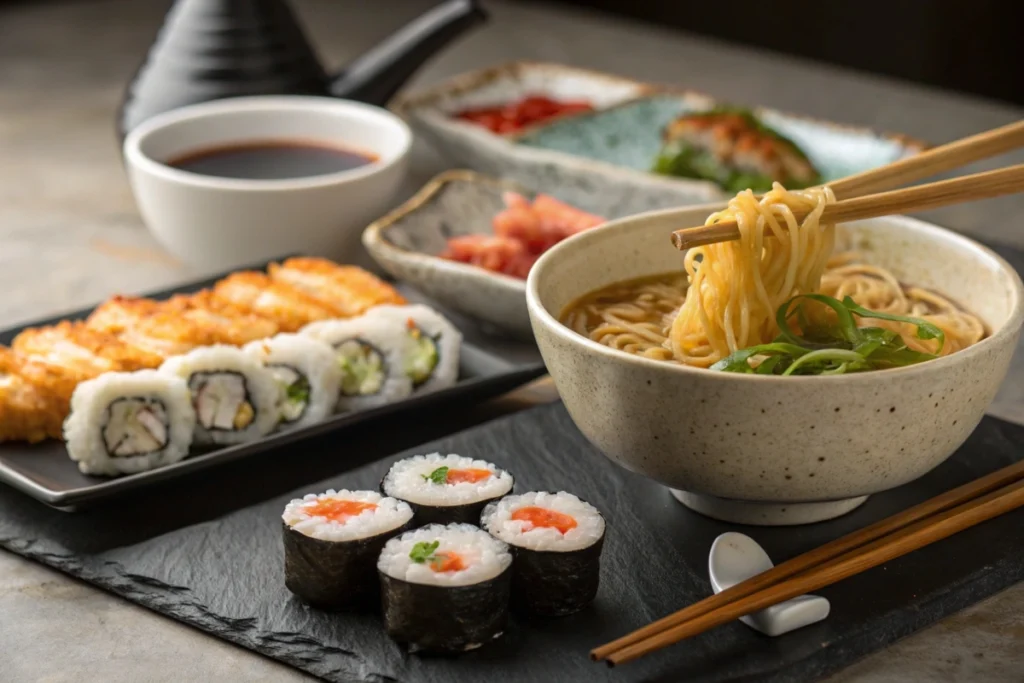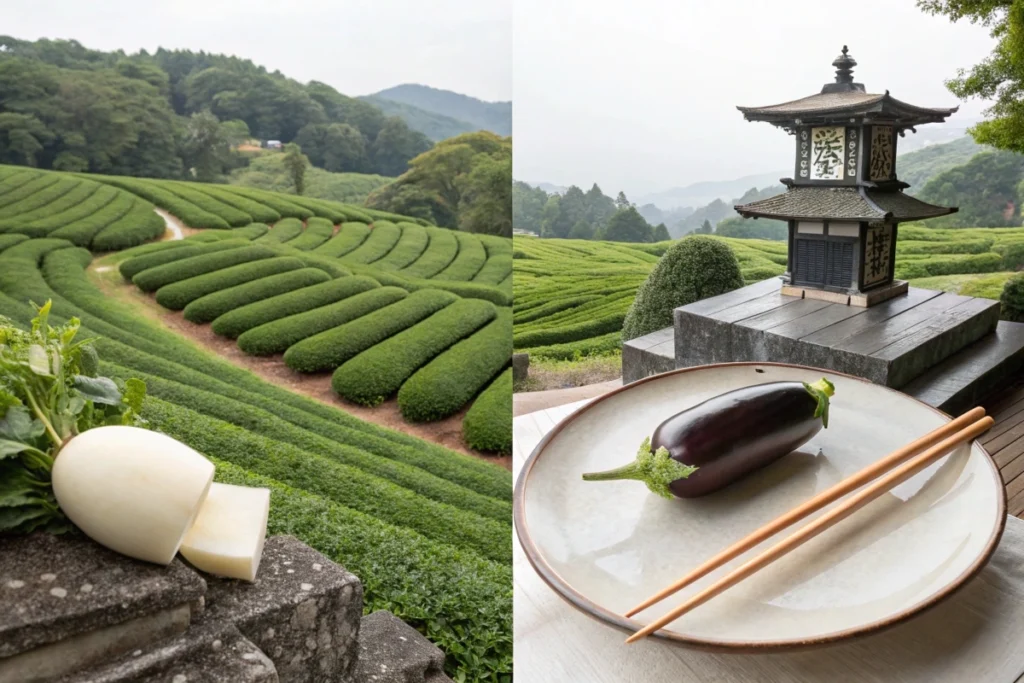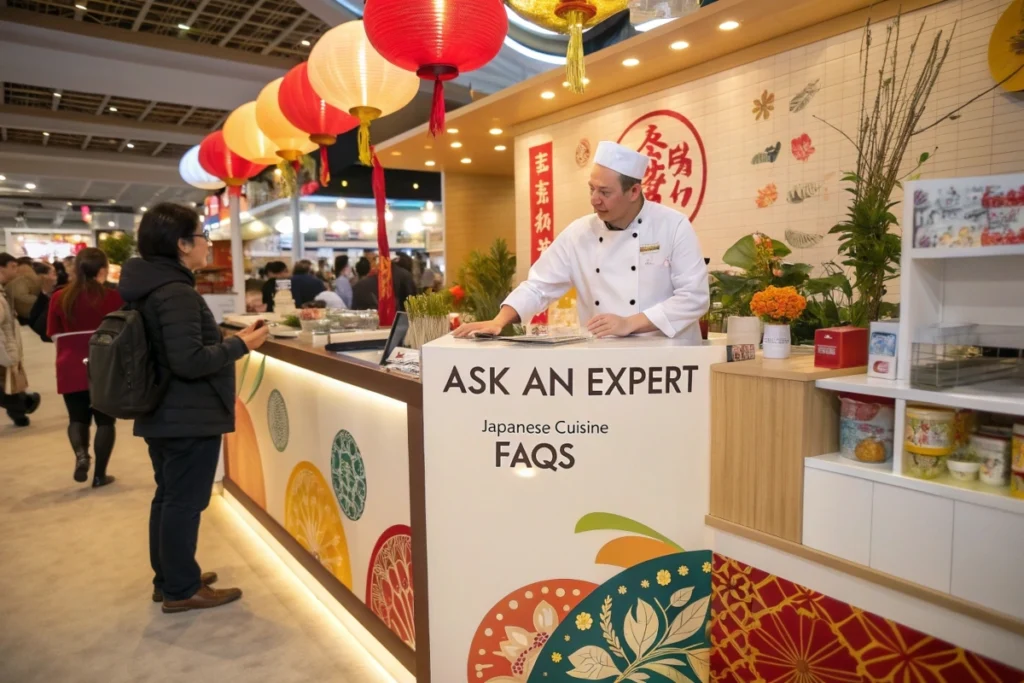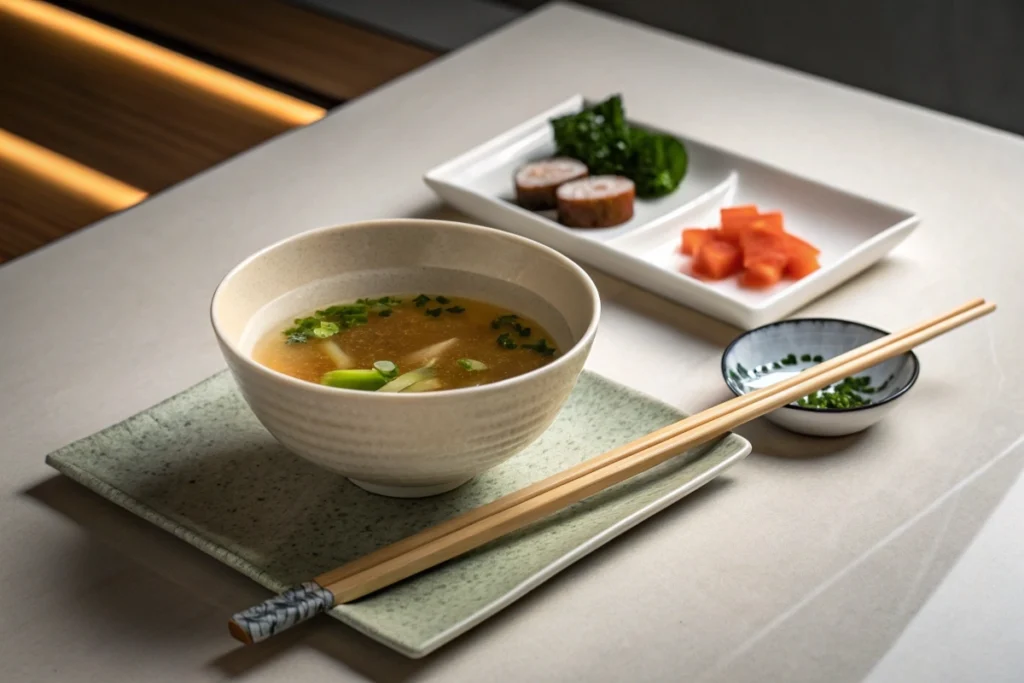Introduction
If you’re looking for the best japanese food to try, you’re entering a world where simplicity meets flavor, and tradition balances innovation. Japanese cuisine often appears deceptively simple, yet each dish relies on precise cooking techniques and fresh, high-quality ingredients. From elaborate kaiseki feasts to casual street food stalls, Japan’s culinary culture offers something for every taste—be it subtle sashimi or bold ramen flavors.
This comprehensive 3,000-word guide aims to highlight the most iconic dishes, their cultural roots, and how you can enjoy them whether you’re dining in Tokyo, at a local Japanese restaurant, or cooking at home. Along the way, we’ll explore how sushi, ramen, and tempura differ from one region to another, as well as how new fusion trends and local produce have reshaped these classics. The end result? A vibrant, dynamic cuisine that continues to influence food scenes worldwide.
For those keen to recreate these flavors in their own kitchen, explore easy Japanese recipes to discover techniques that keep the authenticity intact. Ready to dive in? Let’s begin by examining what truly defines Japan’s culinary identity—an interplay of minimalism, seasonality, and unwavering respect for the freshest ingredients.

1. Defining Japan’s Culinary Identity
The best japanese food doesn’t emerge from random experimentation—it’s rooted in a culinary ethos shaped by geography, culture, and history. Each dish, whether it’s sashimi or yakitori, reflects the country’s longstanding dedication to freshness, seasonality, and careful preparation.
Freshness and Seasonality
Shun is the Japanese concept of enjoying ingredients at their peak of flavor. Locals believe that seasonal produce—like bamboo shoots in spring or chestnuts in autumn—offer the finest taste. This principle extends to fish, vegetables, and even sweets, ensuring that menus rotate throughout the year. By focusing on what’s fresh and local, dishes often maintain natural flavors without excessive seasoning.
Minimalism Meets Precision
Japanese cooking frequently employs minimal seasoning to highlight inherent flavors. Whether it’s lightly salted grilled fish or elegantly sliced sashimi, less is more. However, achieving this “simplicity” requires advanced knife skills, an intimate understanding of heat control, and artful plating. For instance, a steak-japanese-recipe may appear straightforward, but the marinade timing and cooking style emphasize nuance over heavy sauces.
Harmony of Taste
Known as washoku in Japan, the national cuisine embraces a balance of sweet, salty, sour, bitter, and umami. This harmonious approach pervades not only elaborate kaiseki (multi-course) meals but also everyday dishes like miso soup or onigiri (rice balls). Even side dishes—such as pickled daikon or seaweed salad—serve to cleanse the palate and maintain equilibrium among flavors.
Culture and Tradition
Communal dining practices and mindful etiquette also define Japanese cuisine. Shinto and Buddhist influences introduced vegetarian elements, while interactions with foreign traders sparked the introduction of new ingredients, such as sweet potatoes or chili peppers. Over centuries, these external touches fused into Japan’s cooking style without undermining its fundamental identity.
Regional Nuances
Despite its relatively small size, Japan boasts distinct regional differences. Hokkaido in the north celebrates crab and dairy, while Osaka in the Kansai region is famous for street food like takoyaki (octopus balls) and okonomiyaki (savory pancakes). Tokyo’s Edo-style sushi prioritizes fresh, local fish, while Kyushu’s tonkotsu ramen exudes hearty pork-bone flavors.
In sum, Japanese cuisine’s identity hinges on fresh, high-quality ingredients, restrained yet impactful seasoning, and a reverence for nature’s bounty. This foundation paves the way for legendary dishes like sushi, ramen, and tempura, each deserving a spot in any curated list of the “best” Japanese foods. Next, we’ll explore sushi and sashimi, staples that embody Japan’s devotion to the ocean’s delicacies.

2. Sushi, Sashimi & Other Seafood Delights
When you think of the best japanese food, images of sushi and sashimi often come to mind. Japan’s island nation status provides abundant seafood, enabling chefs to specialize in meticulously cut fish and creative combinations of flavors.
Sushi: More Than Just Raw Fish
- Nigiri: A slice of fish or seafood pressed atop vinegared rice. Simplicity reigns here—just a swipe of wasabi or dab of soy sauce.
- Maki Rolls: Seaweed-wrapped rice and fillings like tuna, cucumber, or avocado. Specialty rolls might include tempura shrimp or spicy mayo.
- Temaki (Hand Rolls): Conical sushi wrapped in nori, perfect for casual bites.
Tips:
- Use minimal soy sauce to avoid overpowering the fish.
- Eat nigiri fish-side down to appreciate the flavor.
- Between bites, cleanse your palate with pickled ginger (gari).
Sashimi: Pure Raw Protein
While sushi involves vinegared rice, sashimi is simply sliced fish or seafood—think fresh tuna (maguro), salmon (sake), yellowtail (hamachi), or scallops (hotate). Purists appreciate sashimi for its pure taste and silky texture, often paired with wasabi, soy sauce, or ponzu. If raw fish isn’t your style, some places offer lightly seared or aburi versions, bridging the gap between cooked and uncooked.
Iconic Seafood: Eel, Salmon, and More
- Unagi (Freshwater Eel): Known for its smoky sweetness, often served grilled with a caramelized sauce.
- Ikura (Salmon Roe): Bursting salmon roe garnishes nigiri or appears on top of chirashi (scattered sushi). The briny pop makes it a favorite among roe enthusiasts.
- Kani (Crab): Fresh or imitation crab lends sweetness to classic California rolls or real crab sushi.
Evolution and Fusion
Modern sushi bars might experiment with torched toppings, truffle oil, or inventive fillings like cream cheese. Rolls named “Dragon,” “Rainbow,” or “Volcano” demonstrate how global influences mesh with local creativity. For another approach, see how you can replicate fish-based dishes at home by referencing a japanese-fish-recipes resource for step-by-step guidance.
Beyond the Sushi Bar: Seafood Rice Bowls and Izakaya Bites
Seafood also appears in donburi bowls—like kaisen-don stacked with raw fish—or in izakaya (Japanese pub) menus, where grilled squid or battered shrimp might accompany sake. Even battered eel bones, deep-fried to a crisp, can be found as a bar snack.
In short, sushi and sashimi anchor Japan’s global culinary identity, but they’re far from static. Chefs continue evolving techniques and flavors, reinforcing why these items remain among the top choices for any best japanese food list. Our next section covers the hearty realm of noodles—particularly ramen and udon—embracing warmth and comfort in every slurp.
3. Ramen, Noodles & Comfort Foods
If sushi is the elegant face of best japanese food, ramen and noodles represent its cozy soul. Savory, steamy, and endlessly adaptable, these dishes offer a satisfying contrast to sushi’s precision. Let’s dive into ramen, udon, soba, and more.
Ramen: Diverse Broth & Topping Heaven
Ramen stands as a cornerstone of Japanese comfort food, beloved for robust broths and chewy wheat noodles. Major ramen styles include:
- Tonkotsu: Creamy pork-bone broth, typically topped with chashu (braised pork), green onions, and a soft-boiled egg. Originates in Fukuoka, Kyushu.
- Shoyu: Soy sauce–based, usually lighter but still packed with umami. Toppings vary widely—pork slices, bamboo shoots, and nori often appear.
- Miso: A Sapporo specialty from Hokkaido. Thick, slightly sweet, and perfect for cold weather. Commonly garnished with corn and butter.
- Shio: Salt-based, often the lightest, letting the flavor of the soup’s bones or fish stock shine.
You can find quick ramen shops or specialized ramen bars, each with a unique spin. Noodles-japanese-pan-noodles-recipe might help you emulate these flavors at home, adjusting broth depth or seasoning to your preference.
Udon and Soba: Another Noodle Realm
- Udon: Thick, chewy noodles typically served in a mild broth. Curry udon or tempura udon add flair, with fried shrimp perched atop.
- Soba: Made from buckwheat, these thinner, often brownish noodles can be served cold (zaru soba) or hot in a simple dashi-based soup.
Comfort Beyond Noodles
- Okonomiyaki: Often called a Japanese “savory pancake,” loaded with cabbage, meats, or seafood, then drizzled with tangy sauce and mayonnaise.
- Katsu: Breaded and fried cutlets—pork (tonkatsu) or chicken—often served with shredded cabbage and tonkatsu sauce.
Why They Matter
Unlike sushi’s refined minimalism, these comfort foods highlight Japan’s playful, everyday side. Slurping is encouraged in ramen shops—viewed as a sign of enjoyment. Okonomiyaki stalls bring lively chatter, as diners watch batter cooked on a hotplate. If you’re a vegetarian, you can adapt many soup bases or explore a vegetables-japanese-recipe for plant-friendly noodle bowls.
In summary, noodles and related comfort foods underscore Japan’s capacity for hearty, soul-warming dishes—perfect for winter nights or quick lunches. Next, we’ll shift our focus to rice-based favorites like donburi bowls and grilled specialties, proving Japan’s gastronomic scope extends well beyond raw fish and noodles.
4. Rice & Main Courses: Beyond Sushi
Rice stands at the heart of best japanese food, featured in far more than sushi or onigiri. Japan’s focus on short-grain, slightly sticky rice shapes countless dishes that highlight the cereal’s versatility. Let’s explore the main courses and comfort rice dishes that define Japanese home cooking and restaurant menus alike.
Donburi (Rice Bowls)
Donburi refers to a bowl of rice topped with savory ingredients. Popular versions include:
- Gyudon: Sliced beef simmered in a slightly sweet soy-based sauce, often topped with pickled ginger.
- Katsudon: A breaded, deep-fried pork cutlet (tonkatsu) laid over rice, bound together with beaten egg.
- Oyakodon: Chicken and egg stewed in dashi and soy sauce for a comforting, slightly sweet finish.
These bowls typically come together quickly, making them everyday staples for busy families or salarymen. For a chicken-based twist, see how japanese-chicken-fried-rice-recipe merges staples like leftover rice and minimal seasoning to create a hearty meal.
Bento Culture
Bento boxes exemplify portion control and variety. Each compartment houses a different element—rice, protein, pickles, veggies—ensuring balanced nutrition and visual appeal. Whether homemade or store-bought, bento lunches reflect Japan’s emphasis on efficiency and aesthetics.
Grilled & Fried Favorites
- Yakitori: Skewered chicken parts, from lean breast to juicy thigh or crunchy cartilage, grilled and brushed with tare sauce or salted. Perfect for a quick snack or izakaya outing.
- Teppanyaki: Known abroad as “hibachi,” these sizzling dishes of steak, shrimp, or veggies come to life on an iron griddle. While popular in Western countries, it’s also found in Japan’s steak-focused restaurants.
- Tempura: Light, airy battered seafood or vegetables. Crispiness is paramount, so it’s served with a delicate dipping sauce (tentsuyu) and grated daikon radish.
Curry Rice and Other Western Influences
Japanese curry rice (kare raisu) ranks high among casual comfort foods. Milder and sweeter than Indian curries, Japanese versions often contain onions, carrots, potatoes, and beef or chicken in a thick sauce. If you’re intrigued, check out a japanese-curry-recipe-one-piece that showcases a pop-culture twist. Additionally, hambāgu (hamburger steaks) and omurice (omelet over fried rice) indicate how Japan adapts Western staples to local palates, giving them new flair.
Ultimately, these hearty main courses prove Japanese food is more than just sushi or noodles. Rice unifies a broad spectrum—from simple egg-topped bowls to lavish grilled feasts. By pairing top-notch ingredients with measured seasonings, these dishes highlight Japan’s dedication to balancing texture, taste, and nutrition. Next, we’ll explore the sweet side—desserts, beverages, and special-occasion dishes that add the final flourish to any Japanese meal.
5. Desserts, Drinks & Festive Dishes
Rounding out the best japanese food conversation requires a look at sweets, beverages, and celebratory fare. Though Japanese cuisine typically avoids overly sweet desserts, there’s a world of subtle confections, unique alcoholic drinks, and holiday specialties that complete the gastronomic tapestry.
Desserts and Sweets
- Mochi & Daifuku: Pounded glutinous rice forms chewy mochi, often filled with sweet red bean paste (daifuku). Variations incorporate strawberry or matcha cream.
- Matcha Confections: Matcha (green tea powder) flavors everything from cakes to ice cream, imparting an earthy, slightly bitter note balanced by sugar.
- Dorayaki: Two small pancakes sandwich sweet azuki bean paste. For more sophisticated takes on sweets, japanese-dessert-recipes can offer guidance on puddings, pastries, and beyond.
Drinks and Beverages
- Green Tea (Ryokucha): From everyday sencha to ceremonial-grade matcha, tea is central to Japanese culture.
- Sake: Fermented rice wine with varied flavors—fruity, dry, or umami-rich. Served hot or cold, sake can be paired with sushi or grilled fish.
- Beer and Highballs: Japan’s major breweries produce lagers like Asahi or Sapporo. Highballs mix whisky and soda, a popular pub drink.
Festive & Seasonal Dishes
- Osechi Ryori: Eaten during the New Year, these bento-like boxes feature symbolic foods—like kurikinton (sweet chestnuts and sweet potatoes) for prosperity or kazunoko (herring roe) for fertility.
- Cherry Blossom–Inspired Meals: In spring, hanami picnics revolve around sakura-themed bento and pink-hued sweets.
- Moon-Viewing Sweets (Tsukimi): Autumn’s moon-watching gatherings might include tsukimi dango (moon-viewing dumplings).
Street Sweets & Snacks
- Taiyaki: Fish-shaped waffle-like pastries filled with sweet bean paste or custard.
- Crepes (Japanese-Style): Thinner, loaded with fruit, whipped cream, or chocolate sauces, often sold at stalls in busy neighborhoods.
Balancing Health and Indulgence
Though Japan’s desserts are typically not as sugary as Western pastries, they still offer indulgence. Meanwhile, portion sizes remain modest, reflecting the cultural value of moderation. Seasonal produce—like chestnuts in autumn or yuzu in winter—enhances flavor without excess refined sugar.
In short, Japanese cuisine finishes with gentle, refined sweetness or well-crafted beverages that reflect the same respect for ingredients seen in savory dishes. These elements, along with holiday spreads and street snacks, confirm Japan’s dynamic range. From mochi-based desserts to celebratory new year’s feasts, each addition reveals another facet of this culinary tradition. Now, let’s see how these dishes evolved historically and how you can apply them in practical scenarios.
History and Context of Japanese Food
Japan’s storied culinary tradition extends far beyond the modern restaurants or packaged snacks we see today. The best japanese food we celebrate has roots in centuries of cultural exchange, adaptation, and innovation.
Early Influences
In ancient Japan, fishing and rice cultivation shaped fundamental diets. Grain-based meals and preserved fish dominated daily life. Over time, Chinese cultural influences introduced soy sauce, tofu, and even chopsticks, albeit adapted to fit local preferences. Buddhism promoted vegetarian tendencies in temple cooking—though fish remained key due to the archipelago’s maritime environment.
Medieval Developments
During the Kamakura and Muromachi periods (12th–16th centuries), warrior culture shifted the food landscape. Samurai needed practical, sustaining meals—leading to innovations in pickles and dried fish for portability. Shojin ryori (Buddhist vegetarian cuisine) thrived in temples, emphasizing seasonal vegetables, tofu, and a philosophical approach that avoided waste. These centuries also saw the refinement of soy sauce, miso, and the shaping of a rice-based staple diet.
Edo Period: Rising Food Culture
Between the 17th and 19th centuries, Japan achieved relative stability under Tokugawa rule. Urban centers like Edo (now Tokyo) blossomed. Street foods and specialty eateries emerged—sushi, originally a quick snack, soared in popularity. The tea ceremony, championed by influential figures, showcased the importance of aesthetic simplicity, bridging the gap between daily sustenance and artful practice.
Meiji Restoration & Western Influence
The late 19th century re-opened Japan to global commerce. Western foods—bread, beef, dairy—began trickling into diets. Japanese chefs reimagined these items with local flair (e.g., katsu for cutlets, or “omurice”—an omelet filled with fried rice). This assimilation led to a broader palette of flavors that eventually integrated into mainstream cooking, fueling the notion that Japanese cuisine is not static but perpetually evolving.
Post-War to Present
Following WWII, Japan’s economy surged, accelerating modernization and global outreach. Sushi bars expanded internationally, pioneering a new wave of interest in raw fish. Meanwhile, instant ramen—created in the 1950s—revolutionized convenience dining worldwide. By the late 20th century, Japanese cuisine was recognized for its healthful aspects, culminating in its UNESCO designation as an Intangible Cultural Heritage (washoku) in 2013.
Today, chefs balance honoring tradition with adopting new influences—vegan ramen or fusion sushi rolls, for instance. Social media fosters experimentation, bridging local methods with global tastes. This historical tapestry underscores how each dish, from tempura to bento, is the product of centuries of adaptation, cultural interplay, and unwavering respect for quality.

Practical Examples & Use Cases
Scenario 1: Curating a Japanese Dinner Party
You want to impress friends with the best japanese food in a single evening. Start with a light appetizer of miso soup and edamame. Move to sashimi or a veggie tempura course, then serve a hearty bowl of ramen or a chicken katsu curry. Wrap up with mochi ice cream for dessert. Arrange small plates and bowls elegantly, reflecting the principle of minimal presentation. This multi-course approach mirrors Japanese traditions of balancing different flavors and textures across the meal. If you need a quick marinade trick for your grilled steak, consider a japanese-steak-recipe method that merges East-West influences.
Scenario 2: Navigating a Local Japanese Restaurant
You arrive at a Japanese eatery with an extensive menu—sushi, soba, yakitori, etc. If you’re unsure, pick a balanced set meal (teishoku): it typically includes rice, miso soup, pickles, a main dish like grilled fish or fried chicken, and sometimes a small dessert. This variety ensures you sample multiple facets of Japanese cuisine without feeling overwhelmed.
Scenario 3: Incorporating Quick Dishes into Weeknight Meals
Between work and family obligations, you want something fast yet culturally enriching. Whip up a gyudon (beef bowl) by simmering sliced beef with onions in soy sauce, mirin, and sugar, then pour it over hot rice. In 15 minutes, you get a comforting dinner that’s authentically Japanese. Serve with a quick side—like a vegetables-japanese-recipe(https://thejapaneserecipes.com/vegetables-japanese-recipe/) salad or pickled cucumbers—to keep it balanced.
Scenario 4: Adventurous Cooking with Kids
Introduce children to sushi-making at home. Let them assemble maki rolls with cucumber, avocado, or imitation crab. Decorate the top with sesame seeds or fish roe for color. Not only does this encourage them to try new flavors, but it also teaches them about different food traditions globally.
***Create an image collage in four panels:
- A stylish home dinner party with multiple Japanese courses on a low wooden table.
- A bustling restaurant interior showing a teishoku set meal.
- A quick stovetop shot of someone cooking gyudon.
- A family-friendly sushi-making station with kids rolling maki.*** “Four real-life scenarios illustrating how Japanese dishes fit into casual gatherings, restaurant outings, quick weeknight meals, and fun family activities.”
Recommended filename:best-japanese-food-practical.jpg
FAQs
- What are the top 10 Japanese foods?
While lists vary, common picks include sushi, ramen, tempura, yakitori, shabu-shabu, okonomiyaki, miso soup, soba/udon noodles, unagi (eel), and gyudon. Each represents a distinct flavor profile and cooking method. - What is the most delicious food in Japanese cuisine?
Personal preference dictates “most delicious,” but many travelers adore sashimi for its freshness or tonkotsu ramen for its umami-rich pork bone broth. You might also enjoy the comforting flavors of japanese-curry-recipe-one-piece referencing a pop culture spin. - What is the best thing to eat at a Japanese restaurant if I’m new?
Start with tempura or a teriyaki dish—cooked and lightly seasoned. Sushi lovers might begin with simpler rolls like California or salmon-avocado. Bento sets also let you sample multiple items in a single meal. - What food is uniquely Japanese?
Items like natto (fermented soybeans), fugu (pufferfish), or wagashi (traditional sweets) are uniquely tied to Japan’s cultural heritage. Their preparation and consumption often follow strict guidelines—fugu, for instance, requires specialized training due to its toxicity if mishandled. - Are there vegetarian or vegan options?
Yes, vegan-japanese-recipes(https://thejapaneserecipes.com/vegan-japanese-recipes/) exist, including tofu-based soups, seaweed salads, and vegetable tempura. Miso soup can be adapted by avoiding fish-based dashi. - Do portion sizes differ from Western restaurants?
Often, yes. Japanese portions can be smaller, focusing on variety across multiple small dishes. This style emphasizes balanced nutrition and mindful consumption rather than single large plates. - Is Japanese food always expensive?
Not necessarily. While omakase sushi or kaiseki meals can be pricey, casual options like ramen or donburi bowls are budget-friendly. Street foods and lunchtime specials also offer affordable entries into the cuisine.

Conclusion
From pristine sashimi and comforting ramen to meticulously crafted desserts and festive holiday dishes, best japanese food spans an extensive range of flavor profiles and cooking methods. The hallmarks—seasonality, respect for fresh ingredients, and balanced presentation—are evident across the spectrum, whether you’re dining at a humble izakaya or indulging in a sumptuous kaiseki meal. This synergy of tradition and innovation ensures that Japanese cuisine continues to captivate palates worldwide.
If you’re ready to explore beyond staple sushi rolls, why not dabble in okonomiyaki or a classic traditional-japanese-desserts-recipe? By experimenting with lesser-known dishes—like gyudon or temaki hand rolls—you’ll see firsthand why Japanese cooking is revered not just for its flavors but also for its cultural depth and nutritional balance. And if you’re short on time, quick fixes like miso soup or chicken katsu still offer that quintessential blend of simplicity and taste.
In the end, what defines the “best” is often subjective, shaped by personal preferences and culinary adventures. Yet, Japanese cuisine’s global acclaim stems from a timeless dedication to technique, purity, and creativity. From your home kitchen to the far corners of Tokyo’s dining alleys, these foods invite you to appreciate each bite as an artful, flavorful moment.

